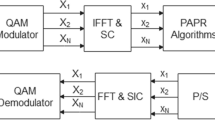Abstract
To utilize white space spectrum in radio environment, transform domain communication system (TDCS) has been proposed to realize an overlay cognitive radio communication system by using spectrum bin nulling and frequency domain spreading. Being similar to OFDM systems, TDCSs still suffer from the problem of high peak to average power ratio (PAPR) in present of high power amplifier. In this paper, a distortionless PAPR reduction method is proposed for TDCS, namely clipping and phase replacement (CPR). Following this method, the clipping noise-dirty phase vector is replaced by an appropriate replacement, which is selected from the identical phase mapping space to avoid systematic performance degradation. Owing to the high computational complexity from exhaust search, an efficient implementation of CPR method is proposed through the iterative PAPR reduction and phase replacement. Moreover, some considerations for practical applications, such as imperfect spectrum sensing and the number of phase taps, are considered. Analytic and simulation results demonstrate that the distortionless CPR PAPR reduction method is a preferable candidate for TDCSs in both the single-user and multi-user scenarios.
Similar content being viewed by others
References
Haykin S. (2005) Cognitive radio: Brain-empowered wireless communication. IEEE Journal on Selected Areas in Communications 23(2): 201–220
Mitola, J. (2000). Cognitive radio: An integrated agent architecture for software defined radio. Ph.D. Dissertation, Royal Institute of Technology.
Budiarjo I., Nikookar H., Ligthart L.P. (2008) Cognitive radio modulation techniques. IEEE Signal Processing Magazine 25(6): 24–34
Andren, C. F., Lucas, L. V., & Schachte, J. A. (1991). Low probability of intercept communication system. U.S. Patent 5029184.
Dillard G. M., Reuter M., Zeidler J., Zeidler B. (2003) Cyclic code shift keying: A low probability of intercept communication technique. IEEE Transactions on Aerospace and Electronic Systems 39(3): 786–798
Fumat G., Charge P., Zoubir A., Prunaret D.F. (2011) Transform domain communication systems from a multidimensional perspective impacts on bit error rate and spectrum efficiency. IET Communications 5(4): 476–483
Chakravarthy V., Xue L., Zhou R., Temple M., Garber F., Kannan R., Vasilakos A. (2009) Novel overlay/underlay cognitive radio waveforms using SD-SMSE framework to enhance spectrum efficiency- part I: Theoretical framework and analysis in AWGN channel. IEEE Transactions on Communication 57(12): 3794–3804
Chakravarthy V., Xue L., Zhou R., Wu Z., Temple M. (2010) Novel overlay/underlay cognitive radio waveforms using SD-SMSE framework to enhance spectrum efficiency-part II: Analysis in fading channels. IEEE Transactions on Communication 58(6): 1868–1876
Hu, S., Guan, Y. L., Bi, G., & Li, S. Q. (2012) Cluster-based transform domain communication systems for high spectrum efficiency. IET Communication, (accepted).
Han C., Wang J., Yang Y. L., Li S. Q. (2008) Addressing the control channel design problem: OFDM-based transform domain communication system in cognitive radio. Computer Networks 52(4): 795–815
Chakravarthy V., Nunez A. S., Stephens J. P. (2005) TDCS, OFDM, and MC-CDMA: A brief tutorial. IEEE Radio Communications 43: S11–S16
Billingsley P. (1995) Probability and measure (3rd ed.). Wiley, New York
Wulich D. (1996) Peak factor in orthogonal multicarrier modulation with variable levels. Electronics Letters 32(20): 1859–1861
Chen H., Haimovich A. M. (2003) Iterative estimation and cancellation of clipping noise for OFDM signals. IEEE Communications Letters 7(7): 305–307
Slimane S. B. (2007) Reducing the peak-to-average power ratio of OFDM signals through precoding. IEEE Transactions on Vehicular Technology 56(2): 686–695
Xiao Y., Lei X., Wen Q. S., Li S. Q. (2007) A class of low complexity PTS techniques for PAPR reduction in OFDM systems. IEEE Signal Processing Letters 14(10): 680–683
Wang X., Tjhung T. T., Ng C. S. (1999) Reduction of peak-to-average power ratio of OFDM system using a companding technique. IEEE Transactions on Broadcasting 45(3): 303–307
Chen H., Pottie G. J. (2002) An orthogonal projection-based approach for PAR reduction in OFDM. IEEE Communications Letters 6(5): 169–171
Tellado, J. (2000). Peak to average power reduction for multicarrier modulation. Ph.D. Dissertation, Stanford University.
Martin R. K., Haker M. (2009) Reduction of peak-to-average power ratio in transform domain communication systems. IEEE Transactions on Wireless Communications 8(9): 4400–4405
Rajbanshi, R., Wyglinski, A. M., & Minden, G. J. (2007). Peak-to-average power ratio analysis for NC-OFDM transmissions. In Proceedings of IEEE 66th Vehicular Technology Conferene, pp. 1351–1355.
Ochiai H., Imai H. (2002) Performance analysis of deliberately clipped OFDM signals. IEEE Transactions on Communications 50(1): 89–101
Stevenson C. R., Chouinard G., Lei Z., Hu W., Shellhammer S. J., Caldwell W. (2009) IEEE 802.22: The first cognitive radio wireless regional area network standard. IEEE Communications Magazine 47(1): 130–138
Swackhammer, P. J., Temple, M. A., & Raines, R. A. (1999). Performance simulation of a transform domain communication system for multiple access applications. In Proceedings of IEEE Military Communications Conference, (Vol. 2, pp. 1055–1059).
Rapp, C. (1991). Effect of the HPA-nonlinearity on a 4-DPSK/OFDM signal for digital sound broadcasting system. In Proceedings of Second European Conference on Satellite Communication, pp. 179–184.
Author information
Authors and Affiliations
Corresponding author
Rights and permissions
About this article
Cite this article
Hu, S., Wu, G., Xiao, Y. et al. Design of Low PAPR Fundamental Modulation Waveform for Transform Domain Communication System. Wireless Pers Commun 71, 2215–2229 (2013). https://doi.org/10.1007/s11277-012-0932-8
Published:
Issue Date:
DOI: https://doi.org/10.1007/s11277-012-0932-8




